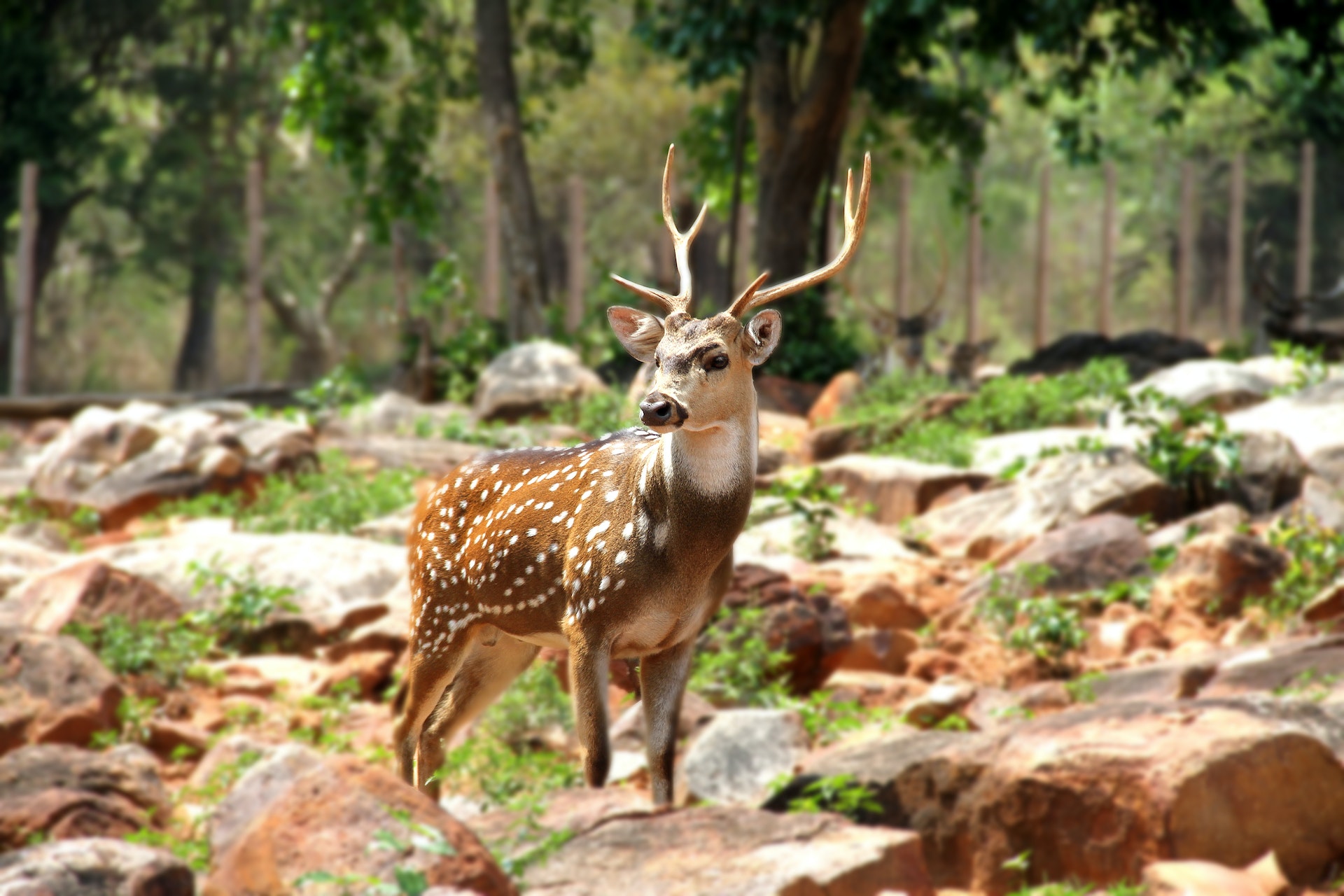Wildlife Sanctuaries In India - A Guide To India's Natural Treasures
Wildlife sanctuaries in India are home to a diverse range of flora and fauna. India is blessed with an abundance of natural beauty and wildlife, and the country has over 500 wildlife sanctuaries and national parks that protect its endangered species.
Author:Tyreece BauerReviewer:Karan EmeryMay 01, 202383.3K Shares1.2M Views

Wildlife sanctuaries in Indiaare home to a diverse range of flora and fauna. India is blessed with an abundance of natural beauty and wildlife, and the country has over 500 wildlife sanctuaries and national parks that protect its endangered species.
Wildlife enthusiasts and nature lovers from around the world visit India to explore these sanctuaries and to witness the beauty of its wild inhabitants.
From the famous Jim Corbett National Park to the lesser-known Nagzira Wildlife Sanctuary, India's wildlife sanctuaries offer a unique and unforgettable experience for visitors.
In this article, we will explore some of the top wildlife sanctuaries in India and what makes them special.
Famous Wildlife Sanctuaries In India
India is home to a diverse range of wildlife sanctuaries, which protect the country's unique flora and fauna. With a vast geography and diverse climates, these sanctuaries offer a glimpse into the country's rich natural heritage.
Here are some of the famous wildlife sanctuaries in India:
Jim Corbett National Park
Located in Uttarakhand, Jim Corbett National Park is one of the oldest national parks in India.
It is home to the Royal Bengal tiger, as well as several other species of animals such as the Indian elephant, sloth bear, and several species of deer.
The park is also known for its beautiful landscapes, which include dense forests, rivers, and waterfalls.
Ranthambore National Park
Situated in Rajasthan, Ranthambore National Park is one of the most popular wildlife sanctuaries in India.
It is famous for its population of Bengal tigers, which can be seen roaming freely in their natural habitat.
The park is also home to a variety of other animals such as leopards, deer, wild boars, and more.
Kaziranga National Park
Located in Assam, Kaziranga National Park is a UNESCO World Heritage Site and is famous for its population of one-horned rhinoceroses.
The park is also home to elephants, tigers, and several species of deer. Kaziranga is also a birdwatcher's paradise, with over 400 species of birds found here.
Bandhavgarh National Park
Situated in Madhya Pradesh, Bandhavgarh National Park is known for its dense tiger population, making it one of the best places in India to spot these majestic animals in the wild.
The park is also home to several other species of animals such as leopards, Indian bison, and more.
Sunderbans National Park
Located in West Bengal, Sunderbans National Park is the largest mangrove forest in the world and is home to the Royal Bengal tiger.
It is also home to several other species of animals such as saltwater crocodiles, Indian python, and more.
These are just a few of the many wildlife sanctuaries in India that offer visitors a chance to experience the country's rich natural heritage.
Whether you are a wildlife enthusiast or simply looking for a unique travel experience, India's wildlife sanctuaries are definitely worth a visit.

Top 10 Wildlife Sanctuaries in India UPSC | Wildlife Sanctuary and National Parks Series - 3
Best Time To Visit Wildlife Sanctuaries In India
Wildlife sanctuaries in India can be visited throughout the year, but the best time to visit depends on the specific sanctuary and the kind of wildlife you want to see. Here's a general guide to help you plan your visit:
- Winter (November to February)- This is the peak season for most wildlife sanctuaries in India. The weather is pleasant, and the wildlife is more visible as they come out to bask in the sun. This is a good time to spot tigers, leopards, elephants, and other large mammals.
- Summer (March to June)- This is a good time to visit sanctuaries located in the northern and central parts of India, such as Ranthambore and Bandhavgarh. The weather is hot, but the vegetation is sparse, making it easier to spot wildlife. It is also a good time to see migratory birds.
- Monsoon (July to October)- This is the least popular time to visit wildlife sanctuaries in India. The heavy rains make it difficult to navigate the forest trails, and many sanctuaries remain closed. However, this is a good time to see the lush greenery and waterfalls.
Before planning your trip, make sure to check the weather and the sanctuary's timings and entry fees. Also, keep in mind that many sanctuaries have limited accommodation, so it is advisable to book in advance.
Birdwatching In Indian Sanctuaries
Birdwatching is a popular activity for nature enthusiasts in Indian wildlife sanctuaries. With over 1300 bird species found in India, the country is a birdwatcher's paradise.
Many of the wildlife sanctuaries in India offer excellent birdwatching opportunities, with a variety of habitats that support a diverse range of bird species. Here are some of the top birdwatching destinations in Indian sanctuaries:
Bharatpur Bird Sanctuary
Also known as Keoladeo National Park, this sanctuary in Rajasthan is a UNESCO World Heritage Site and is home to over 350 species of birds. The park is a wetland and is a wintering site for many migratory bird species.
Sultanpur Bird Sanctuary
Located in Haryana, this sanctuary is a popular destination for birdwatching near Delhi. Over 250 species of birds have been recorded here, including migratory birds like Siberian cranes.
Ranganathittu Bird Sanctuary
Situated in Karnataka, this bird sanctuary is located on an island in the Kaveri river. The sanctuary is home to many species of water birds, including painted storks, Asian openbill storks, and pelicans.
Chilika Lake Bird Sanctuary
Located in Odisha, this bird sanctuary is situated on the largest saltwater lake in Asia. The lake and its surrounding wetlands are home to over 160 species of birds, including flamingos, pelicans, and spoonbills.
When birdwatching in Indian wildlife sanctuaries, it is important to follow guidelines and regulations to ensure the safety of both the birds and the visitors.
Some sanctuaries require permits or the presence of a guide, and visitors should always maintain a safe distance from the wildlife.
Wildlife In Indian Sanctuaries
India is home to an incredible variety of wildlife, and its sanctuaries provide safe havens for a wide range of animals, birds, and reptiles.
Here are some of the most popular wildlife species that can be found in Indian sanctuaries:
- Bengal Tiger- The Bengal tiger is one of the most iconic and endangered species in India. The country has around 50 tiger reserves, which are home to more than 70% of the world's tiger population.
- Indian Elephant- The Indian elephant is another majestic animal that can be found in many Indian sanctuaries. These gentle giants are important to Indian culture and are protected by law.
- Asiatic Lion- The Asiatic lion is a critically endangered species that can only be found in the Gir National Park and Wildlife Sanctuary in Gujarat, India. The sanctuary has played a vital role in the conservation of this species.
- Leopard- The leopard is a solitary and elusive animal that can be found in many Indian sanctuaries. These graceful cats are known for their agility and are excellent climbers.
- Indian Rhino- The Indian rhinoceros is a rare and magnificent species that can be found in a few sanctuaries in India. They are known for their thick skin and single horn.
- Indian Peafowl- The Indian peafowl, also known as the peacock, is the national bird of India and is a common sight in many sanctuaries. The male peacock is famous for its beautiful and colorful plumage.
- Sloth Bear- The sloth bear is a shaggy-haired mammal that can be found in many Indian sanctuaries. These bears are known for their distinctive snouts and love of honey.
These are just a few of the many wildlife species that can be found in Indian sanctuaries. Each sanctuary has its own unique set of animals and birds, and visitors are sure to be amazed by the incredible biodiversity of India's wildlife.
People Also Ask
What Kind Of Animals Can Be Seen In Wildlife Sanctuaries In India?
Wildlife sanctuaries in India are home to a diverse range of animals such as tigers, elephants, lions, rhinoceroses, deer, monkeys, birds, and reptiles.
Can You Stay Overnight At Wildlife Sanctuaries In India?
Yes, many wildlife sanctuaries in India have accommodations for visitors to stay overnight. These can range from basic tents to luxury lodges, and staying overnight can give visitors a chance to see the animals during different times of the day.
Are There Any Guidelines Or Restrictions For Visiting Wildlife Sanctuaries In India?
Yes, visitors to wildlife sanctuaries in India are required to follow certain guidelines and restrictions to ensure the safety of both the visitors and the animals.
Some of these include not feeding the animals, not littering, and not making loud noises or disturbing the natural environment.
Final Thoughts
India is home to a diverse range of wildlife sanctuaries that offer an incredible opportunity to witness the country's rich flora and fauna.
Whether you're interested in tigers, elephants, or birdwatching, there is something for everyone in India's wildlife sanctuaries.
These sanctuaries not only provide a unique opportunity to witness the beauty of nature up close but also play an essential role in conservation efforts.
By visiting these sanctuaries, you can not only have an unforgettable experience but also contribute to preserving India's natural heritage for future generations.

Tyreece Bauer
Author
A trendsetter in the world of digital nomad living, Tyreece Bauer excels in Travel and Cybersecurity. He holds a Bachelor's degree in Computer Science from MIT (Massachusetts Institute of Technology) and is a certified Cybersecurity professional.
As a Digital Nomad, he combines his passion for exploring new destinations with his expertise in ensuring digital security on the go. Tyreece's background includes extensive experience in travel technology, data privacy, and risk management in the travel industry.
He is known for his innovative approach to securing digital systems and protecting sensitive information for travelers and travel companies alike. Tyreece's expertise in cybersecurity for mobile apps, IoT devices, and remote work environments makes him a trusted advisor in the digital nomad community.
Tyreece enjoys documenting his adventures, sharing insights on staying secure while traveling and contributing to the digital nomad lifestyle community.

Karan Emery
Reviewer
Karan Emery, an accomplished researcher and leader in health sciences, biotechnology, and pharmaceuticals, brings over two decades of experience to the table. Holding a Ph.D. in Pharmaceutical Sciences from Stanford University, Karan's credentials underscore her authority in the field.
With a track record of groundbreaking research and numerous peer-reviewed publications in prestigious journals, Karan's expertise is widely recognized in the scientific community.
Her writing style is characterized by its clarity and meticulous attention to detail, making complex scientific concepts accessible to a broad audience. Apart from her professional endeavors, Karan enjoys cooking, learning about different cultures and languages, watching documentaries, and visiting historical landmarks.
Committed to advancing knowledge and improving health outcomes, Karan Emery continues to make significant contributions to the fields of health, biotechnology, and pharmaceuticals.
Latest Articles
Popular Articles